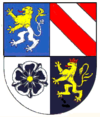Landkreis Zwickauer Land
| Zwickauer Land | ||
|---|---|---|
| District | ||
|
||
 |
||
| Country |
|
|
| State | Saxony | |
| Adm. region | Chemnitz | |
| Disbanded | 2008-08-01 | |
| Capital | Werdau | |
| Area | ||
| • Total | 511.09 km2 (197.33 sq mi) | |
| Population (2001) | ||
| • Total | 133,741 | |
| • Density | 260/km2 (680/sq mi) | |
| Time zone | CET (UTC+1) | |
| • Summer (DST) | CEST (UTC+2) | |
| Vehicle registration | Z | |
| Website | http://www.zwickauerland.de | |
Zwickauer Land is a former Kreis (district) in the south-west of the Free State of Saxony, Germany. Neighboring districts were (from north-east clockwise) Chemnitzer Land, Stollberg, Aue-Schwarzenberg, Vogtlandkreis, and the districts Greiz and Altenburger Land in Thuringia. The district-free city of Zwickau was located in the center of the district and nearly completely surrounded by it.
In early days Zwickau was the starting point for the settlement of a whole region. The first official document of the ”territorim zwickaw” dates from May 1, 1118. The settlement by German farmers took mainly place in the second half of the 12th century. At the same time castles were built. A special area was administered by a bailiff, as a representative of the governor. The Wettiners were the most powerful rulers in Saxony in the 13th century. In the region of Zwickau the sovereign of Schönburg and Wildenfels were given the rule over their comparatively small territories.
With the division of the Saxon country the administrative structures became unclear in Leipzig in 1485. The borderline between albertinian and ernestinian possession was tangent to the Zwickauer city boundary. With the development of the Saxon state uniformed administrative structures began gradually to develop. In the Middle Ages the Saxon area was divided into governor’s residence, apart from the central administration. Out of this new jobs developed in the 15th century. The “administrators” (Amtsmann) practised the jurisdiction, and were responsible for the military quantity and public security.
The administrators came from the rural aristocracy. The noble administrator was promoted to the “chief administrator” (Amtshauptmann) during the following century, who usually supervised two to four offices. At the same time the “Kursaxon” territory was divided into districts for a better administration. The district was headed by a “county administrator” (Kreishauptmann or Oberhauptmann).
During the whole Middle Ages and afterwards – even until our century - the city Zwickau with their surrounding area was regarded as a unit, concerning administrative matters.
Ongoing conflicts, for example the Thirty Years' War and the Seven Years' War, influenced the administration negatively.
...
Wikipedia

